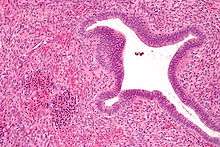Extramedullary hematopoiesis
Extramedullary hematopoiesis (EMH or sometimes EH[1]) refers to hematopoiesis occurring outside of the medulla of the bone (bone marrow).[2]It can be physiologic or pathologic.

Physiologic EMH occurs during embryonic and fetal development mainly. It has been done in many different locations, depending on the moment or the kind of hematopoiesis that is needed in that moment.
Pathologic EMH can occur during adulthood when physiologic hematopoiesis can't work properly in the bone marrow and the hematopoietic stem cells (HSC) have to migrate to other tissues in order to continue with the formation of blood cellular components. Pathologic EMH can be caused by myelofibrosis[3], thalassemias or disorders caused in the hematopoietic system.
Physiologic EMH
During fetal development, hematopoiesis occurs mainly in the fetal liver followed by localization to the bone marrow.[4] Hematopoiesis also takes place in many other tissues or organs such as the yolk sac, the aorta-gonad mesonephros (AGM) region, the spleen, and lymph nodes.
During development, in vertebrates, there are two main phases of hematopoiesis:-
- Primitive hematopoiesis occurs in the yolk sac during early embryonic development. It is characterized by the production of erythroid progenitors or nucleated erythrocytes, also known as erythroblasts or megaloblasts. The main objective of the production of these cells will be the facilitation of tissue oxygenation to support rapid embryonic growth. This primitive phase is transitory and the cells that are produced express embryonic globins, aren't pluripotent, and aren't capable of self-renewal.
- Definitive hematopoiesis differs from the primitive phase through the production of hematopoietic stem cells. The formation of these cells occurs in the AGM later in development. Later, they migrate to the fetal liver where the majority of physiologic EMH takes place. Finally, once the bone marrow has developed, they migrate there. They can also migrate to the spleen and lymph nodes where hematopoiesis can occur, but to a lesser degree.
Pulmonary hematopoiesis also appears to play an important role in adults.[5] In comparison to the bone marrow, where trilineage hematopoiesis occurs, the lungs preferentially contribute to the production of platelets through a resident population of megakaryocytes. This is supported by studies showing that blood leaving the lungs has more platelets and fewer progenitor cells than blood entering the lungs. It has been seen that in cases of severe thrombocytopenia, pulmonary megakaryocytes migrate out of lungs into the bone marrow, where they help to replenish the depleted bone marrow population.
Pathologic EMH
In adults, the majority of hematopoiesis occurs in the bone marrow. Significant production in any other organ is usually the result of a pathological process. The cause of pathologic EMH can be one of many hematological diseases, such as myelofibrosis, or as a result of bone marrow irradiation. Thalassemia and its resultant hemolytic anemia is another important cause of pathologic EMH. Sites of EMH can be widespread including localization to the spleen, liver, lymph nodes, thymus, heart, breast, prostate, broad ligaments, kidneys, adrenal glands, pleura, retroperitoneal tissue, skin, peripheral and cranial nerves, and the spinal canal.
EMH can also be seen as part of the response to systemic inflammation or infection.
References
- Kim, Chang (2010-03-23). "Homeostatic and pathogenic extramedullary hematopoiesis". Journal of Blood Medicine. 1: 13–9. doi:10.2147/jbm.s7224. PMC 3262334. PMID 22282679.
- Birbrair, Alexander; Frenette, Paul S. (2016-03-01). "Niche heterogeneity in the bone marrow". Annals of the New York Academy of Sciences. 1370 (1): 82–96. doi:10.1111/nyas.13016. ISSN 1749-6632. PMC 4938003. PMID 27015419.
- Chunduri S, Gaitonde S, Ciurea SO, Hoffman R, Rondelli D (October 2008). "Pulmonary extramedullary hematopoiesis in patients with myelofibrosis undergoing allogeneic stem cell transplantation. Can induce penile lesions". Haematologica. 93 (10): 1593–5. doi:10.3324/haematol.13203. PMID 18641018.
- Jagannathan-Bogdan, Madhumita; Zon, Leonard I. (2013-06-15). "Hematopoiesis". Development. 140 (12): 2463–2467. doi:10.1242/dev.083147. ISSN 0950-1991. PMC 3666375. PMID 23715539.
- Lefrançais, Emma; Ortiz-Muñoz, Guadalupe; Caudrillier, Axelle; Mallavia, Beñat; Liu, Fengchun; Sayah, David M.; Thornton, Emily E.; Headley, Mark B.; David, Tovo (April 2017). "The lung is a site of platelet biogenesis and a reservoir for haematopoietic progenitors". Nature. 544 (7648): 105–109. doi:10.1038/nature21706. ISSN 1476-4687. PMC 5663284. PMID 28329764.